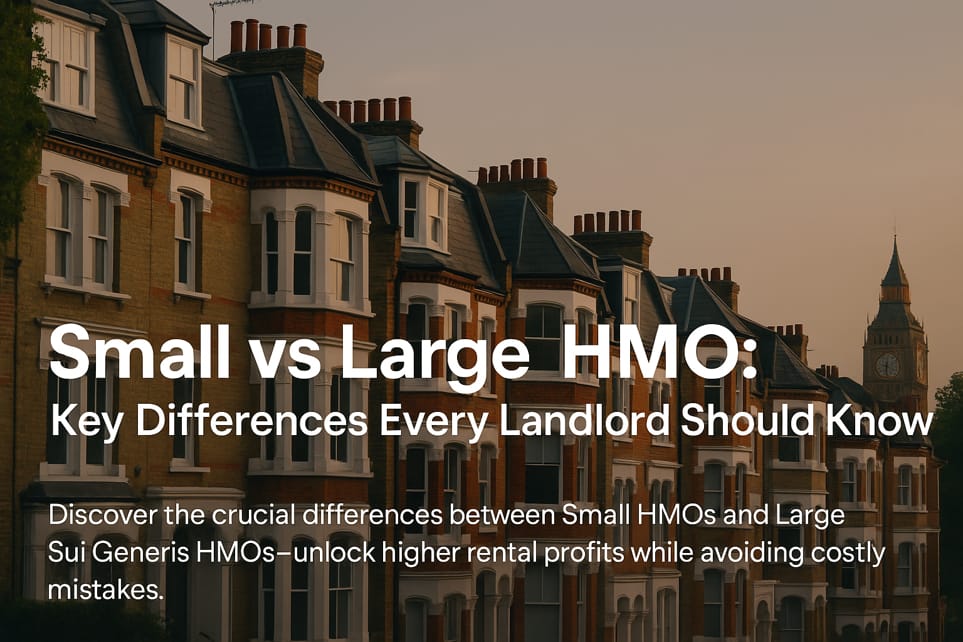
Small vs Large HMO: Key Differences Every Landlord Should Know
Houses in Multiple Occupation (HMOs) offer landlords opportunities to earn higher rental yields than single-tenant properties. However, not all HMOs operate the same way. Landlords must recognize the differences between small and large HMOs to manage properties effectively, comply with legal requirements, and optimise returns.
This article highlights the key distinctions and factors landlords should consider when managing small versus large HMOs.
Key Takeaways
- Small HMOs house 3–4 tenants, are easier to manage, and have lower costs.
- Large HMOs accommodate 5+ tenants, generate higher rental income, but require more complex management.
- Licensing and safety compliance become stricter as tenant numbers increase.
- Tenant turnover is lower in small HMOs and higher in large HMOs, impacting stability.
- Location, market demand, and management capacity are critical factors when choosing between small and large HMOs.
What is a Small HMO?
A small HMO typically accommodates three to four tenants who are not from the same household. Landlords often convert houses or flats into small HMOs to generate higher rental income while keeping management manageable. These properties usually require a HMO license depending on local council regulations.
Small HMOs tend to attract young professionals, students, or single occupants. They allow landlords to gain experience in HMO management without facing the administrative and operational challenges that come with larger properties. Studio 20 Architects recommends small HMOs for first-time landlords because they balance profitability with manageable oversight.
What is a Large HMO?
Large HMOs, also known as “5+ occupancy HMOs”, house five or more tenants from multiple households. These properties demand more complex management due to the higher tenant count.
Large HMOs often include shared kitchens, bathrooms, and living spaces, which means landlords must ensure safety standards, fire precautions, and tenant welfare are strictly maintained. Licensing and regulatory requirements are more rigorous for large HMOs, making it critical for landlords to stay updated with council rules.
Small HMO vs Large HMO: Key Differences at a Glance
| Feature | Small HMO (C4) | Large HMO (Sui Generis) |
|---|---|---|
| No. of Occupants | 3–6 | 7+ |
| Use Class | C4 | Sui Generis |
| Planning Permission | Not always needed (unless Article 4 applies) | Always required |
| Licensing | Depends on local council | Mandatory |
| Fire Safety | Moderate | Strict and extensive |
| Council Scrutiny | Moderate | High |
| Rental Yield | High | Very high (but high overhead) |
Licensing Requirements
Small HMO Licensing:
- Typically applies to properties with 3-4 tenants
- Some councils require mandatory licensing for any property with three or more tenants
- Landlords must meet safety and management standards, including gas and electrical safety checks
Large HMO Licensing:
- Applies to properties with five or more tenants
- Often requires mandatory and additional licensing depending on location
- Landlords face stricter fire safety regulations, such as smoke alarms, fire doors, and emergency lighting
- Councils may carry out inspections more frequently
Licensing affects not only legal compliance but also insurance premiums and tenant trust. Large HMOs often carry higher insurance costs because of the increased risk associated with more tenants.
Rental Income Potential
Small HMOs:
Small HMOs allow landlords to charge slightly higher rents per room than single-occupancy properties. The smaller scale means fewer tenants to manage, which reduces day-to-day operational stress. However, the total rental income is generally lower than that of large HMOs.
Large HMOs:
Large HMOs can generate significantly higher rental yields because of the increased number of tenants. For example, a five-bedroom HMO could earn double or triple the income of a single-family rental. However, higher income comes with increased responsibility in terms of tenant management, maintenance, and compliance.
Landlords should weigh the potential income against the administrative load before deciding which HMO type to manage.
Management Complexity
Small HMOs:
- Easier to manage with fewer tenants
- Minor disputes between tenants are easier to resolve
- Maintenance and repair work is less frequent and less costly
Large HMOs:
- Require more structured management systems
- Tenant conflicts are more frequent and complex
- Maintenance costs increase due to wear and tear from multiple tenants
- Often necessitate professional management companies
Large HMOs often demand detailed tenancy agreements, clear house rules, and regular inspections to prevent issues before they escalate. Landlords may need to invest in property management software or hire an HMO manager to handle day-to-day operations.
Safety and Compliance
Safety and legal compliance form the backbone of HMO management. Failing to comply with HMO regulations can result in fines, prosecution, or license revocation.
Small HMOs:
- Must meet basic fire safety standards, including smoke alarms and fire exits
- Gas safety certificates, electrical inspections, and Legionella risk assessments are necessary
- Easier to ensure compliance due to fewer tenants
Large HMOs:
- Require advanced fire safety measures such as fire doors, emergency lighting, and fire alarms
- Landlords must provide written risk assessments and maintain detailed records
- Compliance management can be time-consuming, but it protects tenants and prevents legal issues
Ignoring safety obligations in large HMOs can lead to serious legal consequences and reputational damage.
Tenant Turnover and Community
Small HMOs:
- Tend to attract more stable tenants, such as young professionals or long-term renters
- Lower turnover reduces void periods and administrative work
- Easier to maintain a positive tenant community
Large HMOs:
- High turnover is common due to the transient nature of tenants, such as students or temporary workers
- Managing tenant relationships requires skill and structured communication
- Landlords may face complaints about noise, cleanliness, or shared facilities
Tenant turnover affects income consistency, so landlords must plan for potential void periods, especially in large HMOs.
Investment Considerations
Small HMOs:
- Lower initial investment compared to large HMOs
- Less risky in terms of management and legal compliance
- Suitable for first-time HMO landlords or those with limited experience
Large HMOs:
- Higher upfront costs, including property conversion, furniture, and licensing fees
- Greater potential returns due to more tenants
- Riskier due to management complexity, tenant disputes, and regulatory obligations
Investors must carefully assess their capacity to manage the property effectively. Large HMOs can be profitable but require experience and dedication.
Location and Market Demand
The success of any HMO depends on location and tenant demand.
Small HMOs:
- Work well in areas with moderate rental demand
- Popular in residential neighborhoods where young professionals or small families live
- Easier to market due to smaller size
Large HMOs:
- Thrive near universities, city centers, or areas with high rental demand
- Can attract multiple tenants quickly if located near public transport or employment hubs
- Marketing requires professional photos, online listings, and effective tenant screening
A strategic location can significantly impact occupancy rates and long-term profitability.
Maintenance and Operational Costs
Small HMOs:
- Maintenance costs are generally lower
- Repairs and upgrades are easier to schedule without disturbing tenants
- Operational costs such as utilities and cleaning are manageable
Large HMOs:
- Higher maintenance due to wear and tear on shared facilities
- Costs for cleaning communal areas, furniture replacement, and repairs increase
- Requires regular inspections to maintain standards
Large HMOs demand proactive maintenance planning. Landlords often need a maintenance reserve to cover unexpected expenses.
FAQs
1. Can I convert a small HMO into a large HMO?
Yes, but you must comply with licensing requirements and safety regulations for large HMOs. Council approval may be necessary.
2. Which type of HMO is better for first-time landlords?
Small HMOs are generally better for beginners due to easier management and lower initial costs.
3. How often should HMO inspections be carried out?
Inspections should be conducted regularly, ideally every 3–6 months, to ensure safety and compliance.
4. Do I need insurance for an HMO?
Yes, both small and large HMOs require specialized insurance covering multiple tenants, fire, and liability risks.
5. Can HMO tenants be from the same household?
No, HMOs must house tenants from different households. Housing multiple members of the same family typically does not count as an HMO.




